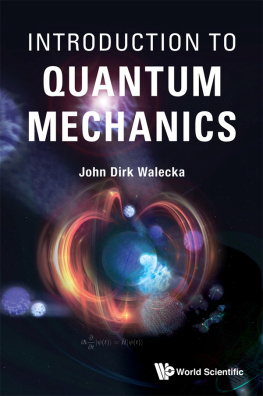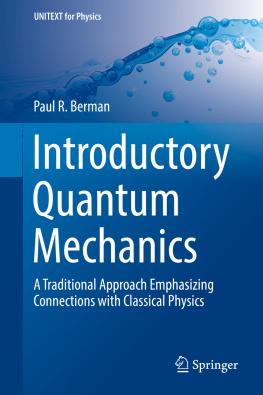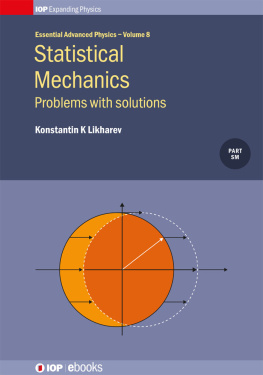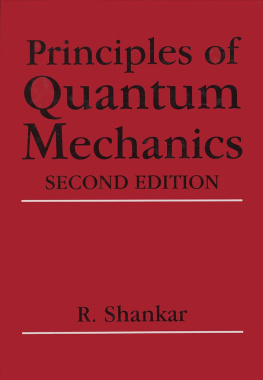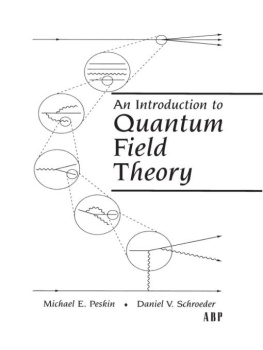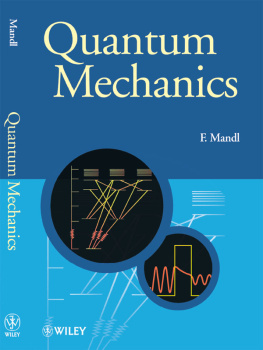THEORETICAL
PHYSICS
SECOND EDITION
A. S. KOMPANEYETS
TRANSLATED FROM THE RUSSIAN
EDITED BY GEORGE YANKOVSKY
DOVER PUBLICATIONS, INC.
Mineola, New York
This translation has been read and approved by the author, Professor A. S. Kompaneyets
Bibliographical Note
This Dover edition, first published in 1962 and reissued in 2012, is an unabridged and corrected republication of the English translation first published by the Foreign Languages Publishing House, Moscow, in 1961.
Library of Congress Catalog Card Number: 63-005516
International Standard Book Number
ISBN-13: 978-0-486-60972-0
ISBN-10: 0-486-60972-3
Manufactured in the United States by Courier Corporation
60972341
www.doverpublications.com
CONTENTS
This book is intended for readers who are acquainted with the course of general physics and analysis of nonspecializing institutions of higher education. It is meant chiefly for engineer-physicists, though it may also be useful to specialists working in fields associated with physicschemists, physical chemists, biophysicists, geophysicists, and astronomers.
Like the natural sciences in general, physics is based primarily on experiment, and, what is more, on quantitative experiment. However, no series of experiments can constitute a theory until a rigorous logical relationship is established between them. Theory not only allows us to systematize the available experimental material, but also makes it possible to predict new facts which can be experimentally verified.
All physical laws are expressed in the form of quantitative relationships. In order to interrelate quantitative laws, theoretical physics appeals to mathematics. The methods of theoretical physics, which are based on mathematics, can be fully mastered only by those who have acquired a very considerable volume of mathematical knowledge. Nevertheless, the basic ideas and results of theoretical physics are readily comprehensible to any reader who has an understanding of differential and integral calculus, and is acquainted with vector algebra. This is the minimum of mathematical knowledge required for an understanding of the text that follows.
At the same time, the aim of this book is not only to give the reader an idea about what theoretical physics is, but also to furnish him with a working knowledge of the basic methods of theoretical physics. For this reason it has been necessary to adhere, as far as possible, to a rigorous exposition. The reader will more readily agree with the conclusions reached if their inevitability has been made obvious to him. In order to activize the work of the student, some of the applications of the theory have been shifted into the exercises, in which the line of reasoning is not so detailed as in the basic text.
In compiling such a relatively small book as this one it has been necessary to cut down on the space devoted to certain important sections of theoretical physics, and omit other branches entirely. For instance, the mechanics of solid media is not included at all since to set out this branch, even in the same detail as the rest of the text, would mean doubling the size of the book. A few results from the mechanics of continuous media are included in the exercises as illustrations in thermodynamics. At the same time, the mechanics and electrodynamics of solid media are less related to the fundamental, gnosiological problems of physics than microscopic electrodynamics, quantum theory, and statistical physics. For this reason, very little space is devoted to macroscopic electrodynamics: the material has been selected in such a way as to show the reader how the transition is made from microscopic electrodynamics to the theory of quasistationary fields and the laws of the propagation of light in media. It is assumed that the reader is familiar with these problems from courses of physics and electricity.
On the whole, the book is mainly intended for the reader who is interested in the physics of elementary processes. These considerations have also dictated the choice of material; as in all nonencyclopaedic manuals, this choice is inevitably somewhat subjective.
In compiling this book, I have made considerable use of the excellent course of theoretical physics of L. D. Landau and E. M. Lifshits. This comprehensive course can be recommended to all those who wish to obtain a profound understanding of theoretical physics.
I should like to express my deep gratitude to my friends who have made important observations: Ya. B. Zeldovich, V. G. Levich, E. L. Feinberg, V. I. Kogan and V. I. Goldansky.
A. Kompaneyets
In this second edition I have attempted to make the presentation more systematic and rigorous without adding any difficulties. In order to do this it has been especially necessary to revise ) setting out the general principles of quantum mechanics; radiation is now considered only with the aid of the quantum theory of the electromagnetic field, since the results obtained from the correspondence principle do not appear sufficiently justified.
Gibbs statistics are included in this edition, which has made it necessary to divide , an introduction to the Gibbs method, which is used as background material for a discussion of thermodynamics. A phenomenological approach to thermodynamics would nowadays appear an anachronism in a course of theoretical physics.
In order not to increase the size of the book overmuch, it has been necessary to omit the theory of beta decay, the variational properties of eigenvalues, and certain other problems included in the first edition.
I am greatly indebted to A. F. Nikiforov and V. B. Uvarov for pointing out several inaccuracies in the first edition of the book.
A. Kompaneyets
MECHANICS
Frames of reference . In order to describe the motion of a mechanical system, it is necessary to specify its position in space as a function of time. Obviously, it is only meaningful to speak of the relative position of any point. For instance, the position of a flying aircraft is given relative to some coordinate system fixed with respect to the earth; the motion of a charged particle in an accelerator is given relative to the accelerator, etc. The system, relative to which the motion is described, is called a frame of reference.
Specification of time . As will be shown later (), specification of time in the general case is also connected with defining the frame of reference in which it is given. The intuitive conception of a universal, unique time, to which we are accustomed in everyday life, is, to a certain extent, an approximation that is only true when the relative speeds of all material particles are small in comparison with the velocity of light. The mechanics of such slow movements is termed Newtonian, since Isaac Newton was the first to formulate its laws.
Newtons laws permit a determination of the position of a mechanical system at an arbitrary instant of time, if the positions and velocities of all points of the system are known at some initial instant, and also if the forces acting in the system are known.
Degrees of freedom of a mechanical system . The number of independent parameters defining the position of a mechanical system in space is termed the number of its degrees of freedom.
The position of a particle in space relative to other bodies is defined with the aid of three independent parameters, for example, its Cartesian coordinates. The position of a system consisting of N particles is determined, in general, by 3 N independent parameters.
However, if the distribution of points is fixed in any way, then the number of degrees of freedom may be less than 3 N . For example, if two points are constrained by some form of rigid nondeformable coupling, then, upon the six Cartesian coordinates of these points, x 1, y 1, z 1, x 2, y 2, z 2, imposed the condition
Next page


